Study on the Oil Well Cement-Based Composites to Prevent Corrosion by Carbon Dioxide and Hydrogen Sulfide at High Temperature
Abstract
1. Introduction
2. Experimental Section
2.1. Experimental Materials
2.2. Experimental Methods
2.2.1. Preparation of Cement Slurry
2.2.2. Construction Performance Tests
- (1)
- Density test
- (2)
- Thickening time test
- (3)
- Water loss test
- (4)
- Rheological test
2.2.3. Compressive Strength Test
2.2.4. Corrosion Depth Test
2.2.5. Micromorphology Test
3. Design of High-Temperature-Resistant High-Density Anti-Corrosion Cement Slurry
3.1. Some Considerations for the Design of Cement Slurry
3.2. High-Temperature-Resistant Manganese Ore Powder Weighting Agent
3.3. Multi-Particle High-Temperature Stabilizer
3.4. High-Temperature-Resistant Preservative Mixed with Organic and Inorganic Materials
4. Evaluation of High-Temperature-Resistant High-Density Anti-Corrosion Cement Slurry
4.1. Construction Performances
4.2. Compressive Strength at High Temperature
4.3. Corrosion Performance
4.4. Micromorphology
5. Conclusions
- (1)
- The manganese ore powder weighting agent is spherical in shape, which can not only effectively improve the density of cement slurry, but also has little effect on the compressive strength. The high-temperature stabilizer is determined to be a mixture of silica fume with different particle sizes, and the performance of the high-temperature stabilizer is better when the proportion of 100 mesh: 300 mesh is equal to 25:75.
- (2)
- The designed slag and resin can effectively reduce the corrosion depth of cement slurry. Mixing inorganic material slag and organic polymer resin as the preservative of cement slurry can reduce the corrosion degree of cement slurry.
- (3)
- The rheology, water loss and thickening time of the designed high-temperature-resistant high-density anti-corrosion cement slurry are excellent, the water loss is less than 50mL, and the thickening time is greater than four hours. The compressive strength of different high-density cement slurries is stable under high temperatures.
- (4)
- After being corroded by hydrogen sulfide and carbon dioxide at high temperature, the designed oil well cement-based composite has low corrosion depth and strong corrosion resistance. The corrosion resistance of the cement slurry is effectively guaranteed by using manganese ore powder, multi-particle silicon powder, slag, and resin preservatives.
Author Contributions
Funding
Institutional Review Board Statement
Informed Consent Statement
Data Availability Statement
Conflicts of Interest
References
- Zhang, X.G.; Zheng, Y.Z.; Guo, Z.M.; Ma, Y.; Wang, Y.; Gu, T.; Jiao, L.B.; Liu, K.Q.; Hu, Z.Z. Effect of CO2 solution on Portland cement paste under flowing, migration, and static conditions. J. Nat. Gas Sci. Eng. 2021, 95, 104179. [Google Scholar] [CrossRef]
- Hoa, L.; Bassler, R.; Bettge, D.; Buggisch, E.; Schiller, B.N.; Beck, M. Corrosion Study on Wellbore Materials for the CO2 Injection Process. Process. 2021, 9, 115. [Google Scholar] [CrossRef]
- Zhou, C.Y.; Zeng, L.H.; Sun, Y.; Zhou, M.; Lei, M.Y.; Wan, W.; Feng, Y. Corrosion behavior and mechanism analysis of oil well cement under CO2 and H2S conditions. Petrophysics 2022, 63, 642–651. [Google Scholar] [CrossRef]
- Omosebi, O.; Maheshwari, H.; Ahmed, R.; Shah, S.; Osisanya, S.; Santra, A.; Saasen, A. Investigating temperature effect on degradation of well cement in HPHT carbonic acid environment. J. Nat. Gas Sci. Eng. 2016, 26, 1344–1362. [Google Scholar] [CrossRef]
- Liu, H.T.; Qin, J.N.; Zhou, B.; Liu, Z.F.; Yuan, Z.T.; Zhang, Z.; Ai, Z.Q.; Pang, X.Y.; Liu, X.L. Effects of Curing Pressure on the Long-Term Strength Retrogression of Oil Well Cement Cured under 200 degrees C. Energies 2022, 15, 6071. [Google Scholar] [CrossRef]
- Lian, J.; Yue, J.; Xing, X.S.; Wu, Z.Q. Design and Evaluation of the Elastic and Anti-Corrosion Cement Slurry for Carbon Dioxide Storage. Energies 2023, 16, 435. [Google Scholar] [CrossRef]
- Yin, S.H.; Yang, Y.F.; Zhang, T.S.; Guo, G.F.; Yu, F. Effect of carbonic acid water on the degradation of Portland cement paste: Corrosion process and kinetics. Constr. Build. Mater. 2015, 91, 39–46. [Google Scholar] [CrossRef]
- Lin, Y.H.; Zhu, D.J.; Zeng, D.Z.; Yang, Y.G.; Shi, T.H.; Deng, K.H.; Ren, C.Q.; Zhang, D.P.; Wang, F. Experimental studies on corrosion of cement in CO2 injection wells under supercritical conditions. Corros. Sci. 2013, 74, 13–21. [Google Scholar] [CrossRef]
- Silva, H.G.C.; Terradillos, P.G.; Zornoza, E.; Mendoza-Rangel, J.M.; Castro-Borges, P.; Alvarado, C.A.J. Improving Sustainability through Corrosion Resistance of Reinforced Concrete by Using a Manufactured Blended Cement and Fly Ash. Sustainability 2018, 10, 2004. [Google Scholar] [CrossRef]
- Tittarelli, F.; Carsana, M.; Bellezze, T. Corrosion behavior of reinforced no-fines concrete. Corros. Sci. 2013, 70, 119–126. [Google Scholar] [CrossRef]
- Wang, D.C.; Noguchi, T.; Nozaki, T. Increasing efficiency of carbon dioxide sequestration through high temperature carbonation of cement-based materials. J. Clean. Prod. 2019, 238, 117980. [Google Scholar] [CrossRef]
- Mei, K.Y.; Cheng, X.W.; Pu, Y.; Ma, Y.; Gao, X.S.; Yu, Y.J.; Zhang, C.M.; Zhuang, J.; Guo, X.Y. Evolution of silicate structure during corrosion of tricalcium silicate (C3S) and dicalcium silicate (C2S) with hydrogen sulphide (H2S). Corros. Sci. 2020, 163, 108301. [Google Scholar] [CrossRef]
- Mei, K.Y.; Cheng, X.W.; Gu, T.; Zheng, Y.Z.; Gong, P.; Li, B.; Zhang, C.M.; Zhang, L.W.; Dai, B.B. Effects of Fe and Al ions during hydrogen sulphide (H2S)-induced corrosion of tetracalcium aluminoferrite (C(4)AF) and tricalcium aluminate (C(3)A). J. Hazard. Mater. 2021, 403, 123928. [Google Scholar] [CrossRef] [PubMed]
- Omosebi, O.; Maheshwari, H.; Ahmed, R.; Shah, S.; Osisanya, S. Experimental study study of the effects of CO2 concentration and pressure at elevated temperature on the mechanical integrity of oil and gas well cement. J. Nat. Gas Sci. Eng. 2017, 44, 299–313. [Google Scholar] [CrossRef]
- Xu, Y.; Hu, M.M.; Chen, D.; Liu, Z.X.; Yu, Y.J.; Zhang, H.; Guo, J.T. Performance and working mechanism of amphoteric polycarboxylate-based dispersant and sulfonated acetone formaldehyde polycondensate-based dispersant in oil well cement. Constr. Build. Mater. 2020, 233, 117147. [Google Scholar] [CrossRef]
- Yan, S.M.; Wang, Y.J.; Wang, F.H.; Yang, S.; Wu, Y.N.; Yan, S.D. Synthesis and mechanism study of temperature-resistant fluid loss reducer for oil well cement. Adv. Cem. Res. 2017, 29, 183–193. [Google Scholar] [CrossRef]
- Tiemeyer, C.; Plank, J. Working mechanism of a high temperature (200 degrees C) synthetic cement retarder and its interaction with an AMPS (R)-based fluid loss polymer in oil well cement. J. Appl. Polym. Sci. 2012, 124, 4772–4781. [Google Scholar] [CrossRef]
- Tian, Y.; Yu, R.G.; Zhang, N.; Yang, Y.T. Preparation of high-temperature-resistant and high-strength low-density oil well cement. Emerg. Mater. Res. 2020, 9, 163–167. [Google Scholar] [CrossRef]
- Abdulmalek, A.; Salaheldin, E.; Adjei, A.S. Influence of weighting materials on the properties of oil-well cement. ACS Omega 2020, 5, 27618–27625. [Google Scholar] [CrossRef]
- Ahmed, A.; Mahmoud, A.A.; Elkatatny, S.; Chen, W.Q. The effect of weighting materials on oil-well cement properties while drilling deep wells. Sustainability 2019, 11, 6776. [Google Scholar] [CrossRef]
- Qin, J.K.; Pang, X.Y.; Cheng, G.D.; Bu, Y.H.; Liu, H.J. Influences of different admixtures on the properties of oil well cement systems at HPHT conditions. Cem. Concr. Compos. 2021, 123, 104202. [Google Scholar] [CrossRef]
- Costa, B.L.D.; de Souza, G.G.; Freitas, J.C.D.; Araujo, R.G.D.; Santos, P.H.S. Silica content influence on cement compressive strength in wells subjected to steam injection. J. Pet. Sci. Eng. 2017, 158, 626–633. [Google Scholar] [CrossRef]
- Liu, H.J.; Bu, Y.H.; Zhou, A.N.; Du, J.P.; Zhou, L.W.; Pang, X.Y. Silica sand enhanced cement mortar for cementing steam injection well up to 380 degrees C. Constr. Build. Mater. 2021, 308, 125142. [Google Scholar] [CrossRef]
- Yuan, B.; Wang, Y.Q.; Yang, Y.G.; Xie, Y.Q.; Li, Y. Wellbore sealing integrity of nanosilica-latex modified cement in natural gas reservoirs with high H2S contents. Constr. Build. Mater. 2019, 192, 621–632. [Google Scholar] [CrossRef]
- Peng, Z.G.; Lv, F.L.; Feng, Q.; Zheng, Y. Enhancing the CO2-H2S corrosion resistance of oil well cement with a modified epoxy resin. Constr. Build. Mater. 2022, 326, 126854. [Google Scholar] [CrossRef]
- Bai, M.X.; Zhang, Z.C.; Fu, X.F. A review on well integrity issues for CO2 geological storage and enhanced gas recovery. Renew. Sustain. Energy Rev. 2016, 59, 920–926. [Google Scholar] [CrossRef]
- Grandclerc, A.; Gueguen-Minerbe, M.; Nour, I.; Dangla, P.; Chaussadent, T. Impact of cement composition on the adsorption of hydrogen sulphide and its subsequent oxidation onto cementitious material surfaces. Constr. Build. Mater. 2017, 152, 576–586. [Google Scholar] [CrossRef]
- Liu, J.L.; Jia, Y.M. Experimental investigation on durability of cement-steel pipe for wellbores under CO2 geological storage environment. Constr. Build. Mater. 2020, 236, 117589. [Google Scholar] [CrossRef]
- Carey, J.W. Geochemistry of Wellbore Integrity in CO2 Sequestration: Portland Cement-Steel-Brine-CO2 Interactions. Rev. Mineral. Geochem. 2013, 77, 505–539. [Google Scholar] [CrossRef]
- Li, X.; O’Moore, L.; Song, Y.R.; Bond, P.L.; Yuan, Z.G.; Wilkie, S.; Hanzic, L.; Jiang, G. The rapid chemically induced corrosion of concrete sewers at high H2S concentration. Water Res. 2019, 162, 95–104. [Google Scholar] [CrossRef]
- Bao, H.; Xu, G.; Wang, Q.; Peng, Y.Z.; Liu, J.Y. Study on the deterioration mechanism of cement-based materials in acid water containing aggressive carbon dioxide. Constr. Build. Mater. 2020, 243, 118233. [Google Scholar] [CrossRef]
- Savija, B.; Lukovic, M. Carbonation of slurrys: Understanding, challenges, and opportunities. Constr. Build. Mater. 2016, 117, 285–301. [Google Scholar] [CrossRef]
- Xu, B.H.; Yuan, B.; Wang, Y.Q. Anti-corrosion cement for sour gas (H2S-CO2) storage and production of HTHP deep wells. Appl. Geochem. 2018, 96, 155–163. [Google Scholar] [CrossRef]
- Zhang, Y.; Xu, M.; Song, J.; Wang, C.; Wang, X.; Hamad, B.A. Study on the corrosion change law and prediction model of cement stone in oil wells with CO2 corrosion in ultra-high-temperature acid gas wells. Constr. Build. Mater. 2022, 323, 125879. [Google Scholar] [CrossRef]
- Wang, J.P.; Xiong, Y.M. Research and Application of High-Density Cementing Slurry Technology under the Condition of Oil-based Drilling Fluid in Salt Formation. Arab. J. Sci. Eng. 2021, 47, 7069–7079. [Google Scholar] [CrossRef]
- Zhou, S.M.; Li, G.S.; Wang, Q.C. Research and preparation of ultra-heavy slurry. Pet. Explor. Dev. 2013, 40, 115–118. [Google Scholar] [CrossRef]
- Abdelmelek, N.; Lubloy, E. Effects of Elevated Temperatures on the Properties of High Strength Cement Paste Containing Silica Fume. Period. Polytech.-Civ. Eng. 2022, 66, 127–137. [Google Scholar] [CrossRef]
- Xu, B.H.; Yuan, B.; Wang, Y.Q.; Zeng, S.P.; Yang, Y.H. Nanosilica-latex reduction carbonation-induced degradation in cement of CO2 geological storage wells. J. Nat. Gas Sci. Eng. 2019, 65, 237–247. [Google Scholar] [CrossRef]
- Wu, Z.Q.; Liu, H.J.; Qu, X.; Wu, G.A.; Xing, X.S.; Cheng, X.W.; Ni, X.C. Improvement of Calcium Aluminate Cement Containing Blast Furnace Slag at 50 degrees C and 315 degrees C. Front. Mater. 2022, 8, 807596. [Google Scholar] [CrossRef]
- Gao, X.; Yao, X.; Wang, C.Y.; Geng, C.Z.; Yang, T. Properties and microstructure of eco-friendly alkali-activated slag cements under hydrothermal conditions relevant to well cementing applications. Constr. Build. Mater. 2022, 318, 125973. [Google Scholar] [CrossRef]
- Martin-Del-Rio, J.J.; Marquez, G.; Flores-Ales, V.; Romero, E.; Rey, O. Comparison of polymer-based slag-mud slurries used for drilling jobs of steam stimulated wells in the Lagunillas oilfield. Int. J. Oil Gas Coal Technol. 2021, 26, 1–11. [Google Scholar] [CrossRef]
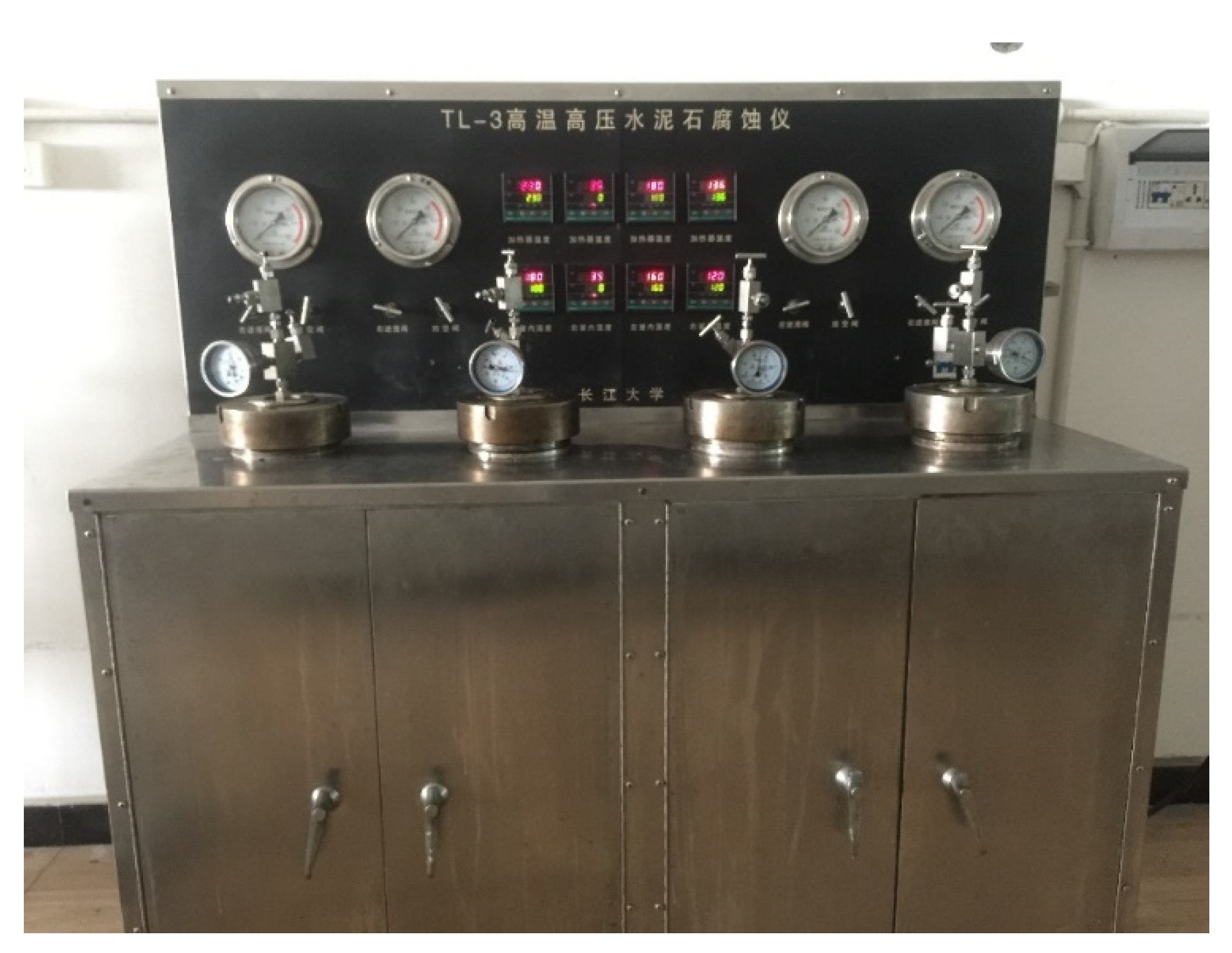


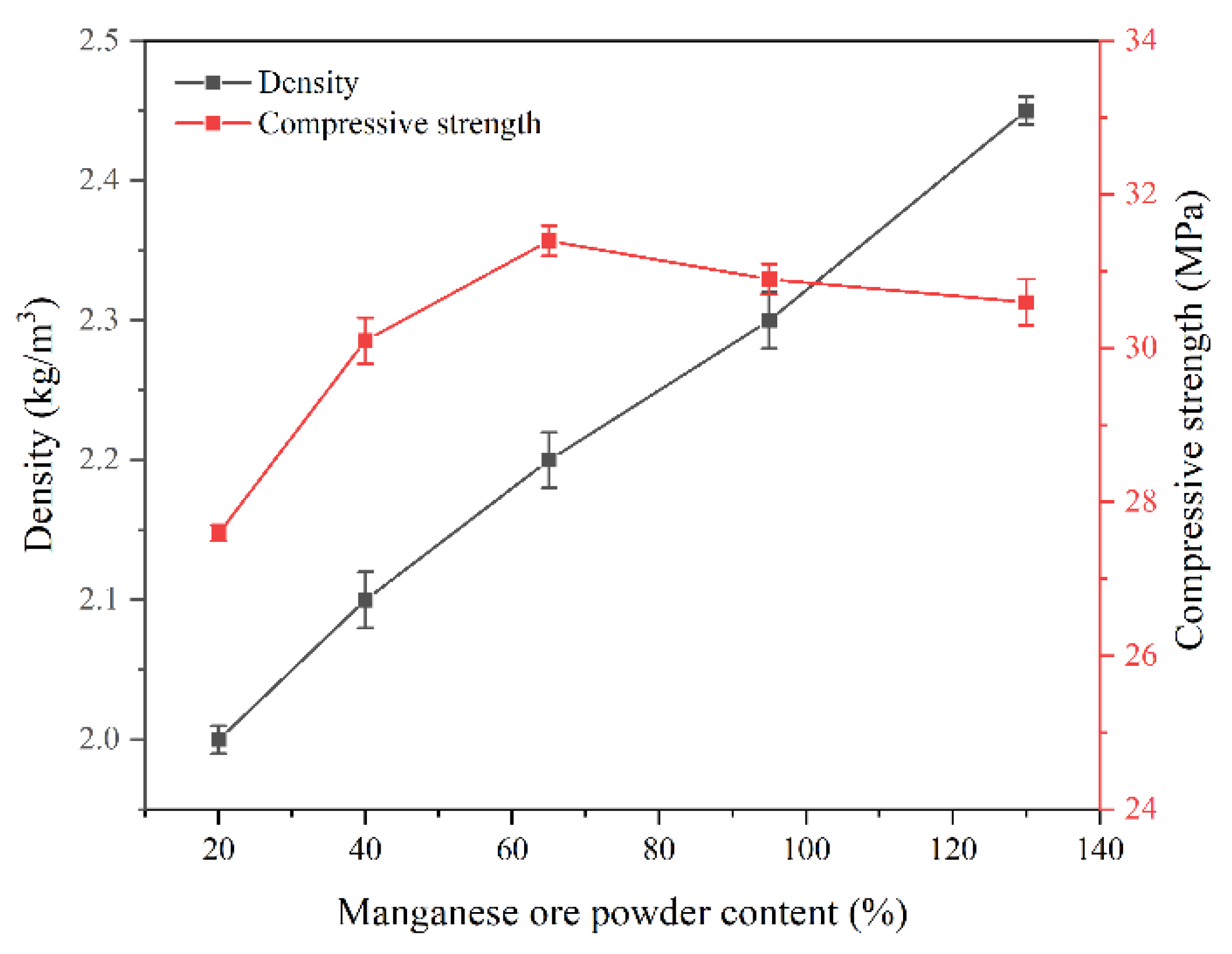
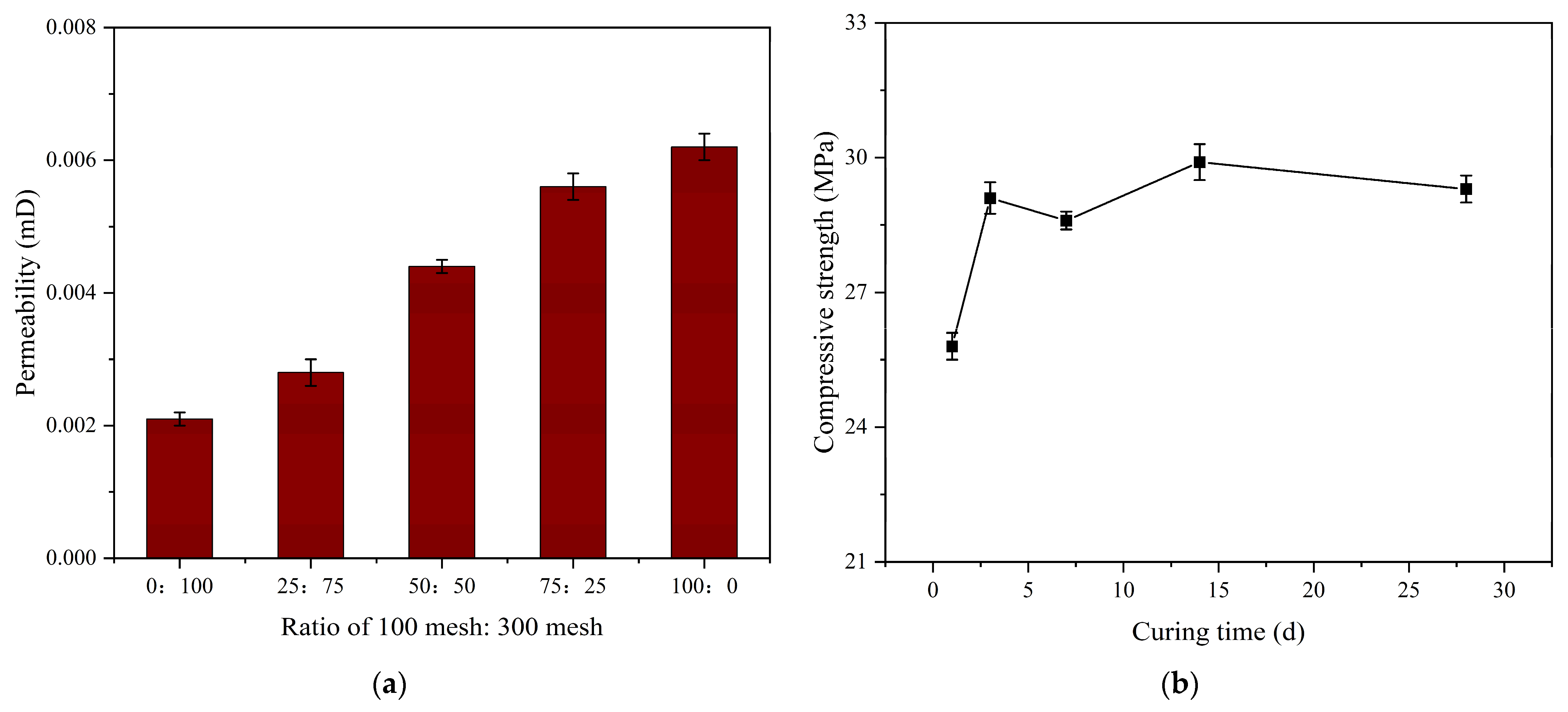
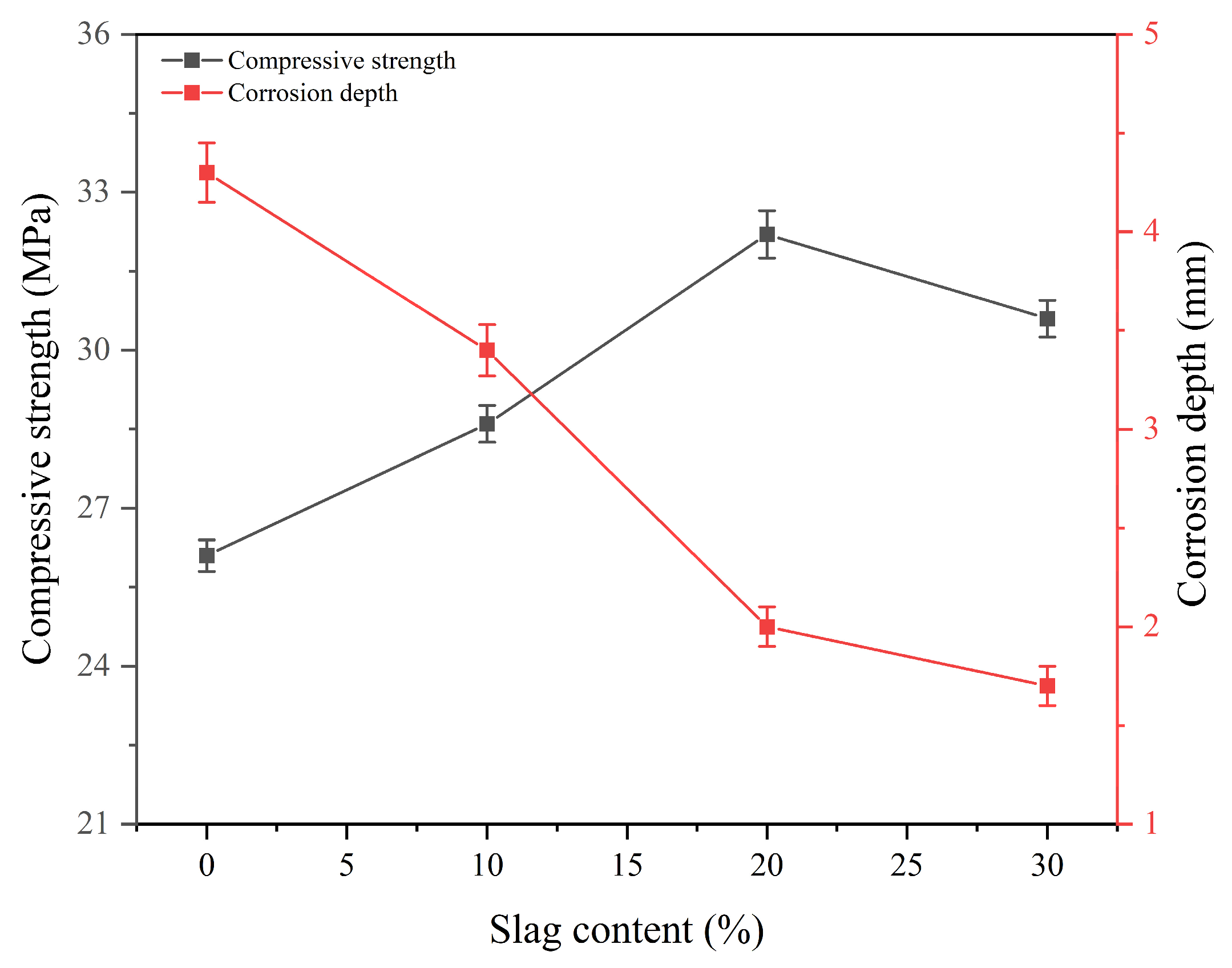
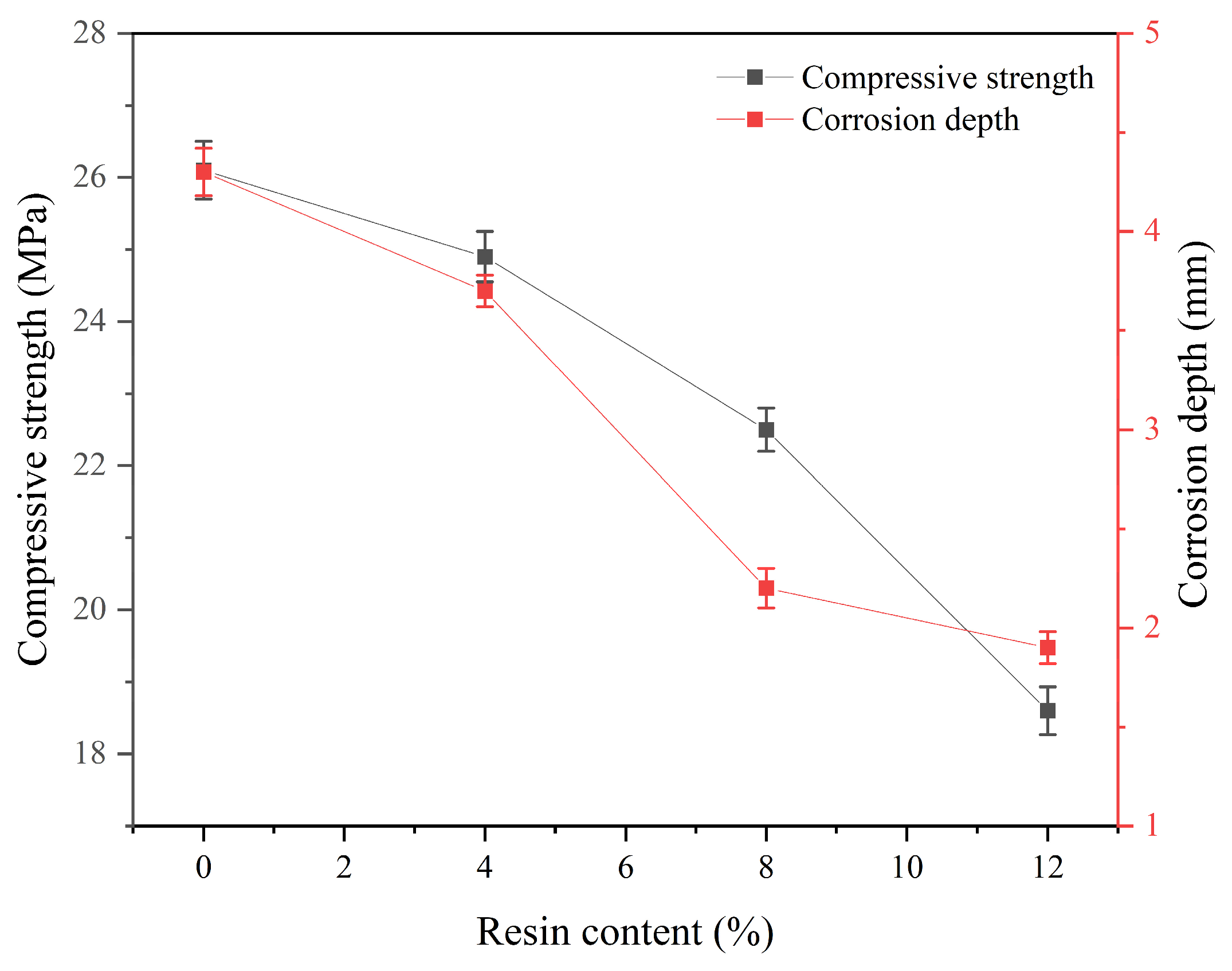
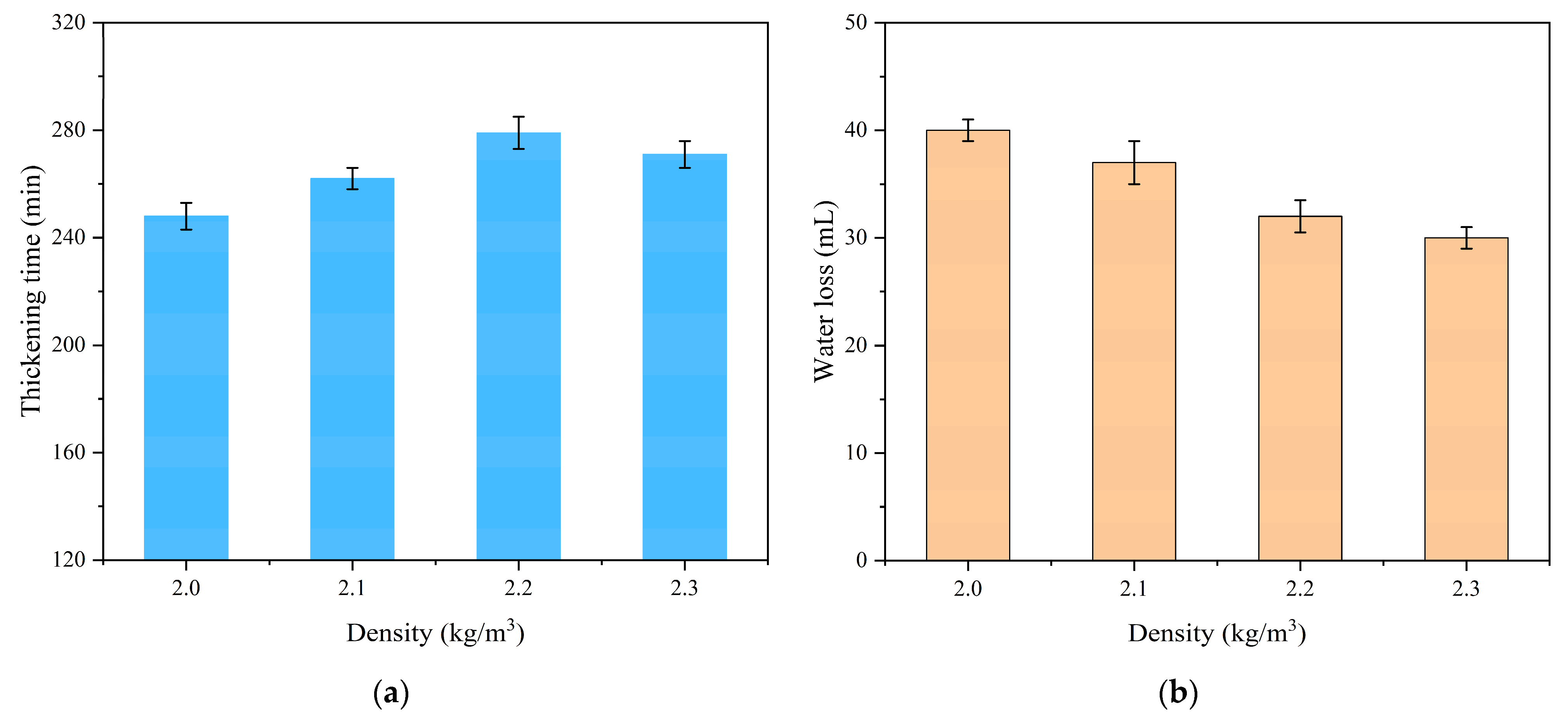
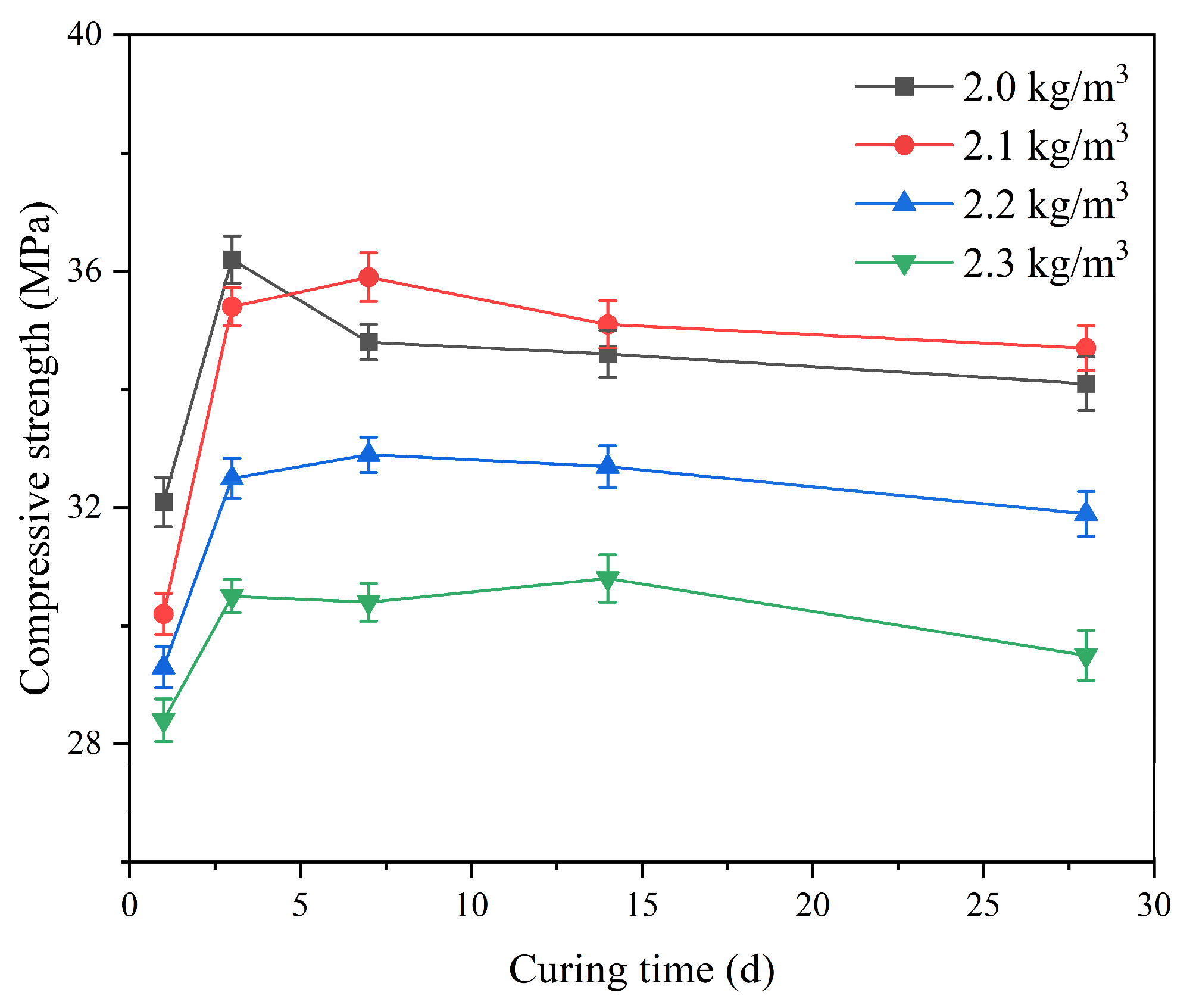



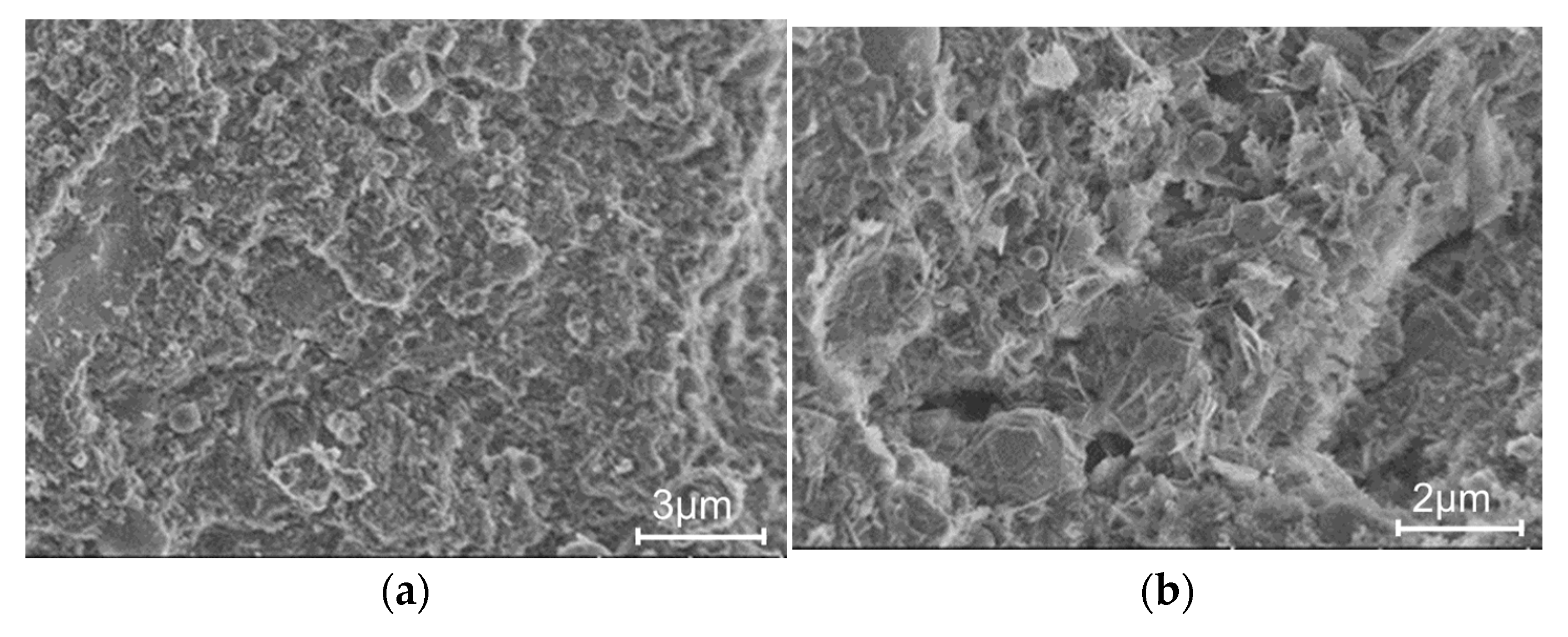
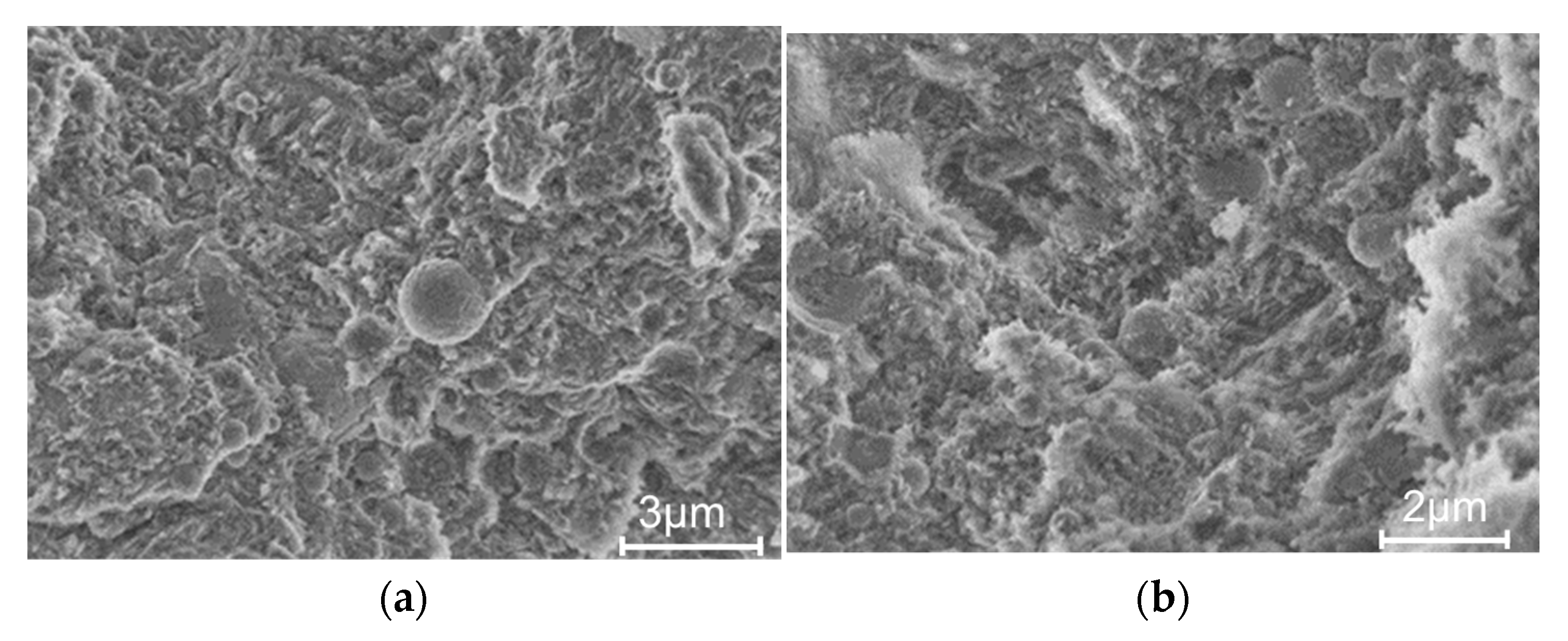
| Component | CaO | SiO2 | Fe2O3 | Al2O3 | MgO | Na2O + K2 | Others |
|---|---|---|---|---|---|---|---|
| Content (%) | 64.2 | 22.5 | 4.4 | 4.1 | 1.6 | 0.38 | 2.82 |
| Density (kg/m3) | Cement | Water | Fluid Loss Reducer | Retarder | Dispersant | Silica Fume | Weighting Agent | Slag | Resin |
|---|---|---|---|---|---|---|---|---|---|
| 2.0 | 100 | 41 | 7 | 2.5 | 2 | 35 | 16 | 20 | 8 |
| 2.1 | 100 | 42 | 7 | 2.5 | 3 | 35 | 32 | 18 | 8 |
| 2.2 | 100 | 44 | 6 | 2.2 | 4 | 35 | 52 | 18 | 8 |
| 2.3 | 100 | 45 | 6 | 2 | 4.5 | 35 | 79 | 16 | 10 |
| 100 Mesh:300 Mesh | 300 r/min | 200 r/min | 100 r/min | 6 r/min | 3 r/min | Free Liquid (%) |
|---|---|---|---|---|---|---|
| 0:100 | — | 205 | 114 | 12 | 9 | 0 |
| 25:75 | 237 | 165 | 89 | 9 | 5 | 0 |
| 50:50 | 221 | 158 | 86 | 8 | 5 | 0 |
| 75:25 | 205 | 142 | 80 | 7 | 4 | 0.1 |
| 100:0 | 186 | 123 | 66 | 4 | 2 | 0.2 |
| Density (kg/m3) | 300 r/min | 200 r/min | 100 r/min | 6 r/min | 3 r/min |
|---|---|---|---|---|---|
| 2.0 | 223 | 160 | 87 | 9 | 5 |
| 2.1 | 243 | 178 | 93 | 6 | 4 |
| 2.2 | 277 | 197 | 105 | 7 | 5 |
| 2.3 | 253 | 189 | 110 | 9 | 6 |
Disclaimer/Publisher’s Note: The statements, opinions and data contained in all publications are solely those of the individual author(s) and contributor(s) and not of MDPI and/or the editor(s). MDPI and/or the editor(s) disclaim responsibility for any injury to people or property resulting from any ideas, methods, instructions or products referred to in the content. |
© 2023 by the authors. Licensee MDPI, Basel, Switzerland. This article is an open access article distributed under the terms and conditions of the Creative Commons Attribution (CC BY) license (https://creativecommons.org/licenses/by/4.0/).
Share and Cite
Tan, C.; Wang, M.; Chen, R.; You, F. Study on the Oil Well Cement-Based Composites to Prevent Corrosion by Carbon Dioxide and Hydrogen Sulfide at High Temperature. Coatings 2023, 13, 729. https://doi.org/10.3390/coatings13040729
Tan C, Wang M, Chen R, You F. Study on the Oil Well Cement-Based Composites to Prevent Corrosion by Carbon Dioxide and Hydrogen Sulfide at High Temperature. Coatings. 2023; 13(4):729. https://doi.org/10.3390/coatings13040729
Chicago/Turabian StyleTan, Chunqin, Mu Wang, Rongyao Chen, and Fuchang You. 2023. "Study on the Oil Well Cement-Based Composites to Prevent Corrosion by Carbon Dioxide and Hydrogen Sulfide at High Temperature" Coatings 13, no. 4: 729. https://doi.org/10.3390/coatings13040729
APA StyleTan, C., Wang, M., Chen, R., & You, F. (2023). Study on the Oil Well Cement-Based Composites to Prevent Corrosion by Carbon Dioxide and Hydrogen Sulfide at High Temperature. Coatings, 13(4), 729. https://doi.org/10.3390/coatings13040729







